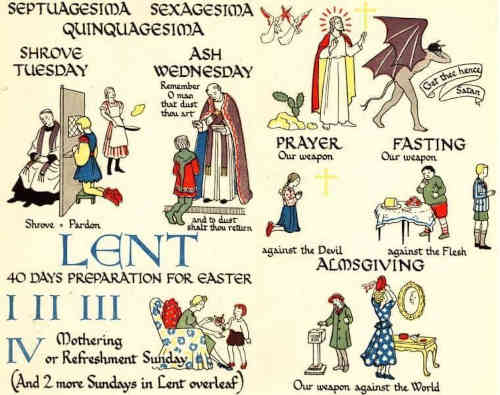
This coming Sunday is the third Sunday before Lent (the ninth Sunday before Easter) – traditionally, in the West, called “Septuagesima Sunday“, and beginning a two-and-a-half-week Gesima Season, with Septuagesima, Sexagesima, and Quinquagesima Sundays. As with so much in liturgy, we don’t know why it is called “Septuagesima” (“seventieth”). Best guess is that it follows the pattern of the First Sunday in Lent being Quadragesima, and Quinquagesima actually being 50 days from Easter – the other two, Septuagesima and Sexagesima, then become approximates.
Septuagesima was regarded as a beginning, and so, in monasteries, the readings began from Genesis.
This season developed from the early sixth to the early seventh centuries as the result of monks extending the forty-day prepaschal fast for progressively longer periods. In doing so they may have been imitating Oriental churches that had to begin their time of penance at least eight weeks before Easter, since they fasted only five days a week, excluding Saturdays as well as Sundays. If Holy Week was not considered part of Lent, then the Lenten fast had to begin nine weeks before Easter, on the day that coincides with the Roman Septuagesima Sunday. Efforts to make the weeks of fasting in Rome match those of the East would have been supported by several seventh-century popes who were Orientals. Another reason for lengthening the fast at this time is that “repeated Gothic and Lombard invasions caused people to be predisposed to supplementary practices of prayers and penance.” By the time of Pope Gregory the Great (590-604), the three Sundays before the beginning of Lent had acquired special Masses, the texts of which are found in the ancient sacramentaries.
Patrick Regan, Advent to Pentecost: Comparing the Seasons in the Ordinary and Extraordinary Forms of the Roman Rite, pp. 77-78
In the East preparation before Lent has “Meatfare” and “Cheesefare” Sundays, with some fasting between these and Lent beginning on the Monday known as “Clean Monday,” with no meat or cheese.
Anglicanism’s Book of Common Prayer included Septuagesima, Sexagesima, Quinquagesima. This Gesima season was abandoned after Vatican II and incorporated into Ordinary Time. It is still continued in some traditions.
In the Gesima tradition, the “Alleluia” ceases on Septuagesima Sunday until the Easter Season. From this Sunday, there are 40 days until Easter Day not counting Thursdays, Saturdays, and Sundays. For many, this is the start of carnival season, culminating in Shrove Tuesday (Mardi Gras).
In Common Worship, the Church of England has gone back to a “before Lent” period of varying length. The Church of England counts forward from Christmas to Candlemas (2 February); after that the CofE counts backwards to Lent. Unlinked from this counting, however, is the readings – the readings in the CofE are from the Revised Common Lectionary, linked when counting forward Christmas to Candlemas; but there’s no link between the title of the Sunday (and its collect) and the readings after Candlemas. One advantage of this unlinking is the emphasis I often make: there is no theme at this time of year – those who want, at this time of year, to restrict the readings and collect (Opening Prayer) to a tight theme misunderstand how the readings and prayers work.
In Roman Catholicism, and churches following the Vatican II liturgical reforms:
Septuagesima time, an anticipation of Lent, is suppressed….This revision returns Lent to its original unity and significance. The season of Septuagesima is abolished since it had no meaning of its own….It was difficult to explain the season to the people, and even the names of its Sundays were obscure. Most of all, it took away from the ‘newness’ of the penitence theme, proper to the liturgy of Lent.
Regan, Advent to Pentecost: Comparing the Seasons in the Ordinary and Extraordinary Forms of the Roman Rite, p. 77-78
The Anglican Church in Aotearoa, New Zealand and Polynesia (ACANZP) attempts to stitch or paste together mummy Church of England’s recent refocus on Candlemas (Presentation, February 2) but without counting backwards to Lent after that, as the CofE does; ACANZP then jumps over to the RC counting. So, although ACANZP claims Ordinary Time begins after February 2, its first Sunday in Ordinary Time (January 6, this year) is suddenly called “The 5th Sunday in Ordinary Time” to catch up with the rest of the planet! Also, being the Anglican Church of Or, Septuagesima, and the Gesima Season, far from being suppressed in the Anglican Church of Or, are still part of its formularies, and probably celebrated by some.
Source of the image: Enid M Chadwick, My Book of the Church’s Year (A R Mowbray and Co., London & Oxford, 1948) – thanks to the information provided by Robert in the comments.



The image is from Enid M Chadwick: My Book of the Church’s Year (A R Mowbray and Co., London & Oxford, 1948). I have the 2nd Impression (1954 ) in front of me.
And, Bosco, this might interest you: https://en.wikipedia.org/wiki/Enid_Chadwick
Thanks so much, Robert – I’ve updated the page with that information. Blessings.
My pleasure. It made me Google her so now I know about Enid Chadwick.